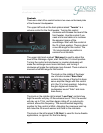
ver 1.0
21
2121
21
~ÄëçäìíÉ=ÑáÇÉäáíó™
cones and the loudspeaker enclosure all work in unison to produce
bass output that descends evenly to below your hearing limits.
500 watt Class D Servo Amplifier
While the advantages of metal cones include extreme stiffness
resulting in very low distortion and break-up, one problem is that of
greater mass. To over come this, Genesis had to build an
amplification system of great wattage, and high damping factor. The
servo system also places extraordinary demands on the amplifier
because the system uses enormous amounts of current to make the
woofer follow the input signal. Combined with the metal cones, this
means that the amplifier used must deliver extraordinarily large
amounts of clean power.
In the Genesis 5, the built-in amplifier was specifically designed and
tuned for low frequencies in order to produce “floorshakingly
musical” bass to power the servo woofers.
One side benefit of this powered woofer system is that almost any
sized amplifier can be used to drive the Genesis 5. No longer must
one choose between having an amplifier with enough power to drive
the woofers, and a smaller amplifier having better spatial and tonal
characters. Nevertheless, we generally recommend 60 watts as a
minimum.
The Acoustic Plinth
The suspension for the speaker comprises three elements:
1) The neoprene shock absorbers are tuned to isolate and
decouple the loudspeaker cabinet for optimal bass response
no matter what surface the loudspeaker sits on. For
extremely hard floors (bare marble, granite, etc), a set of
softer shock absorbers (included) may be substituted. Use
the softer shock absorbers only if the speakers sounds too
hard and unrelenting on hard floors. If a very resonant floor
(such as if the speakers were to be used on a wooden stage),
the softer absorbers may also be used for further decoupling.
2) The skeletal frame acts as a tuned absorber. Made of a
sandwich of Baltic birch ply with a constrained vibration
absorbent material, no two parts of the frame will resonate at
the same frequencies. This ensures that all midrange
frequencies are “dumped” at the foot of the cabinet so that


















